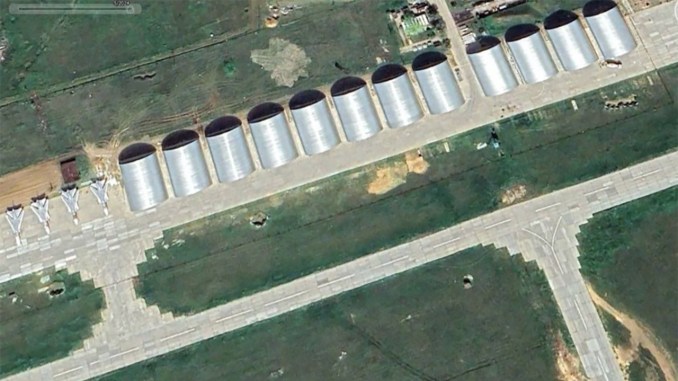
New Aircraft Shelters at Marinovka Air Base: Deception, Protection, or Strategic Defense?
Satellite photos show aircraft shelters at Russia’s Marinovka air base in Russia’s Volgograd region, 300-km from the border with Ukraine. These come after Ukraine’s strikes with ATACMS (Army Tactical Missile System) on Crimea’s Belbek air base on May 15, 2024, and the destruction of an S-400 AD (Air Defense) system at Mospyne on May 22-23.
The attack on Belbek destroyed MiG-31, MiG-29 and Su-27 fighters, satellite images from Maxar later showed.
Maxar pictures show Russia’s destroyed MiG-31, MiG-29, Su-27, as well as a depot at Belbek airbase in Russia-occupied Crimea. This will significantly reduce Russia’s air raids capacities. Imagine what these ATACMS could do with Belgorod airfields from where Russia bombs Kharkiv. pic.twitter.com/PmJpkMYvdZ
— Sergej Sumlenny, LL.M (@sumlenny) May 17, 2024
There are different assessments on the Marinovka shelters’ effectiveness. Even Russia-affiliated military commentators note that its air bases have long missed such protective hangars, and that they have come late in the war. The images, Google Earth, show “hangars in anticipation of deep strikes by Ukraine,” said Ukrainian military blogger Igor Sushko.
Russia is now constructing hangars in anticipation of deep strikes by Ukraine. Marinovka airfield is 300km from Ukraine, home to Su-24 and S-34 striker-bombers.
Must be nice for Russia to have had nearly 2.5 years to do this as Ukraine’s allies actively protected such targets. pic.twitter.com/yHAhphMURl— Igor Sushko (@igorsushko) May 30, 2024
The base is home to Su-24 Fencer and Su-34 Fullback fighter-bombers. “Must be nice for Russia to have had nearly 2.5 years to do this as Ukraine’s allies actively protected such targets.” The pictures show 12 such hangars and four uncovered Su-24 jets lined up beside each other.
Deception, Protection or Both?
An instance from September 2023 might shed some light on the current practice. Satellite photos then revealed Russia had placed rubber “tires” on its bombers at Engels Air Base, perhaps to provide added protection from drone and, possibly, Neptune missile strikes. The base hosts Russia’s Tu-95 and Tu-160 strategic bombers.
This was because the Ukrainian Neptune, originally an anti-ship missile converted for land-strike roles, has a new thermal seeker that will not match the aircraft’s changed infrared signature, with the one loaded in its memory.
The car tires were placed on the wings and fuselage. At the time, experts said the tires could also be expected to bounce off attacking UAVs before they could hit the plane’s airframe. Even a single hit with a low-explosive warhead is enough to put an aircraft out of operation for a long time.
On February 26, 2023, Ukraine-affiliated Belarusian partisan group BYPOL, claimed to have damaged an A-50U AWACS (Airborne Warning and Control System) by landing a kamikaze quadcopter on its radar disc at Machulishchy air base in Belarus.
Russia’s Thinking
The thinking behind the tires, or the hangars, therefore could meanwhile be to make the aircraft hard to spot on optical cameras. The possibility of the aircraft having tires around them being decoys, also cannot be ruled out. Deceptions force an attacker to strike a false target, and even if not always successful, are also expected to complicate an adversary’s planning. It injects a sense of doubt as to whether the targets identified are fake or real.
Russia is aware Ukraine depends heavily on Western military supplies, electronic intelligence (ELINT), optical reconnaissance and airborne radar guidance from NATO aircraft like the E-3 Sentry AWACS, RQ-4 Global Hawk, RC-135 Rivet and MQ-9 Reaper. Western military advisors are also unofficially present on the ground.
This implies a lot of resources and man-hours go into planning, conducting attacks by sifting through and analyzing optical, electronic intelligence. In Marinovoka’s case, not being aware exactly how many and what aircraft the base hosts makes it difficult for Ukraine to judge its value. Neither Ukraine nor NATO would want to expend resources and time determining by focusing on only one base.
Another remote expectation on the part of Russian planners could be to actually draw out Ukrainian attacks and possibly gain further insight into its planning and NATO’s surveillance tactics. The above conclusions, however, remain in the broad realm of speculations.
The inferences are solely based on the fact that Moscow has chosen an attritional, drawn out ‘long war,’ that trades off several tactical mistakes, for incremental strategic gains. Otherwise, it could just be an haphazard attempt by the RuMoD (Russian Ministry of Defense) to protect aircraft for lack of hardened shelters, especially after the strike at Belbek.
‘Little, Late but Not Useless’
Leading Russia-affiliated Telegram channel ‘FighterBomber’, noted both these possibilities. “It’s clear that these arched canopies were built in a hurry and because there was nowhere else to go.”
The channel inferred how the new shelters are possibly built with citizens “donations” – an ongoing crowdfunding effort by Russia’s Telegram ‘Milbloggers’, to meet its troops’ everyday battlefield needs. This is to meet the gap left by larger bureaucratic and public financing hurdles that caters for capital expenditure. The endeavor has the Kremlin’s blessings, seen in Vladimir Putin’s publicized meetings with them.
Noting that “some authorities in the Ministry of Defense seem to be reluctantly expanding their minds,” FighterBomber’ said finer details like how many hangars per airfield, the manner of installation, whether they would be “strengthened by blocks or embankments,” are not known.
A weapons-tactical possibility could be to shield against bombette-releasing ‘area weapons’ like the M39 or the M39A1 ATACMS missile, that were employed in strike at the Belbek and Mospyne strikes. Both carry M74 submunitions in their warhead, where the M39 carries 950 and the M39A1 holds 300 bomblets, enough to permanently disable thin-bodied systems like aircraft and AD radars. Militarnyi said the “hangars” are “to protect aircraft from attack drones and missiles with a cluster warhead.”
But FighterBomber discards this possibility. These appear to be “lightweight shelters” built from the funds from “caring citizen sponsors.” “We need major reinforced concrete shelters. Citizens won’t be able to handle this.”
FighterBomber however also acknowledged its advantages. “First of all, you can’t see how many planes there are. Not where they are located specifically or whether they are located at all. Even in the event of a strike, it will be difficult to obtain real results of defeat, and in some cases impossible.”
- SEO Powered Content & PR Distribution. Get Amplified Today.
- PlatoData.Network Vertical Generative Ai. Empower Yourself. Access Here.
- PlatoAiStream. Web3 Intelligence. Knowledge Amplified. Access Here.
- PlatoESG. Carbon, CleanTech, Energy, Environment, Solar, Waste Management. Access Here.
- PlatoHealth. Biotech and Clinical Trials Intelligence. Access Here.
- Source: https://theaviationist.com/2024/06/01/satellite-images-marinovka/




